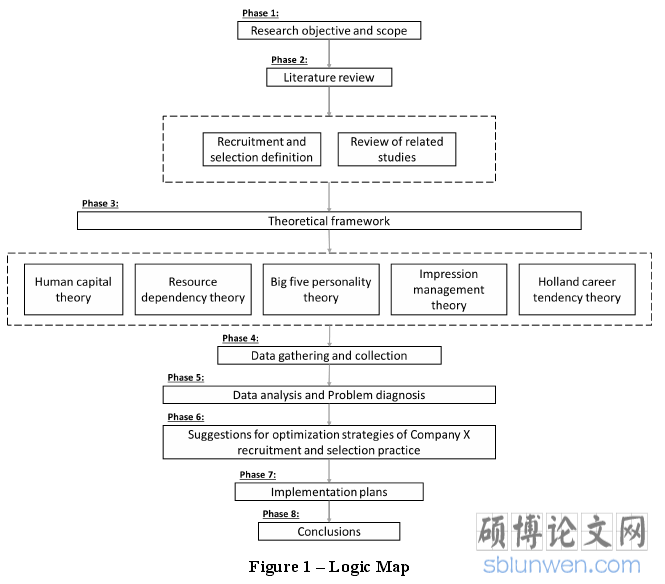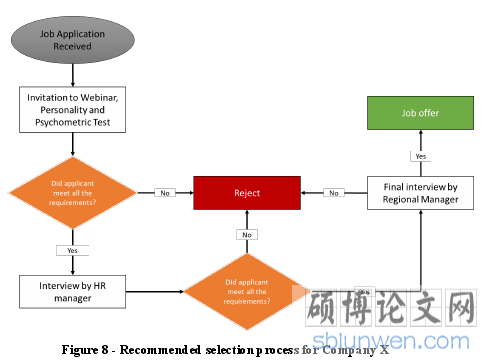Chapter One Introduction
1.1. Introduction to the Research
1.1.1. Research Background
Human Resource Management (HRM) function used to be considered as the least important department in the organization and companies usually paid little to no attention when recruiting workers. In recruitment and selection, educational backgrounds are seen as a good indicator and predictor of success for jobs applicants. Candidates are selected based on the university they graduated from instead of the relevant skills they actually possess. Job interviews were omitted in China and organizations offered jobs to university graduates without seeing them in person (Huo and Glinow, 1995).
However, there recently has been a dramatic change in recruitment and selection practice. In today's challenging work environment, HRM plays a vital role in an organization. The effort to attract, motivate and retain employees is a challenge for every organization. A shortage of talented workers has risen as the demand for specific skill sets continues to outpace the supply of suitable candidates. Effective recruitment and selection, attracting the best candidates and ultimately reducing staff turnover are fundamental in an organization. Quite a reasonable amount of time and energy is required in order to recruit and select perfect candidates not only for the job position but also fit well in the company's culture.
........................
1.2. Research Significance
The study is to provide information on the various methods and procedures of recruitment and selection process that may be used to achieve organizational objectives. The study will reiterate the need for Company X to follow the due process in attracting and retaining potential employees. This recruitment and selection process will set out the possible practices of ensuring that the best-qualified workers are recruited on merit and that the process is free from bias selectivity, nepotism and discrimination. It will also serve as a useful instrument in analyzing the policies of recruitment and the environmental factors that affect the standard practices of the HR functions. As every country's development backbone is dependent on its scientific researches, the study also looks generally to the unfair recruitment and selection practices that lead to inefficiencies in many organizations as a result of corruption, unfair discrimination, and the famous whom you know becoming a negotiated order in our societies and that may ineffectively influence the socio-economic development of China. Finally, the study will also serve as existing literature for researchers with similar research objectives. Also, it will be considered as the material of reference in issues concerning recruitment and selections as an HR function irrespective of the sector within the economy.
This study seeks to investigate the recruitment and selection practices of Company X having understood that effective recruitment and selection practices lead to high performance and increased productivity. Company X requires an acceptable and effective recruitment procedure that may attract competent, qualified candidates who can be hired and retained to deliver scientific research for the country China, as every country's development backbone is dependent on its scientific investigations. The study also looks generally to the questionable recruitment and selection practices that lead to inefficiencies in many organizations as a result of corruption, nepotism, and favoritism.

...........................
Chapter Two Theoretical Background and Literature Review
2.1. Theoretical Framework
2.1.1. Human Capital Theory
In the literature, human capital refers to the productive capabilities of people (Berker, 1964). An employee's skills, experience, and knowledge have economic value to organizations because they enable it to be more productive and adaptable. Therefore, people are the organizations human capital. Human capital has worth in the marketplace; however, the potential value of human capital can be fully realized only with the effective use of human resource management. Therefore, all cost related to eliciting productive behaviors from employees, including those related to motivating, monitoring, and retaining them constitute human capital investments made in anticipation of future returns. Bontis et al. (1999) define human capital as the human factor in the organization, the combined intelligence, skills, and proficiency that gives the organization its distinctive appeal. The human fundamentals of the organization are those that are capable of learning, changing, innovating, and providing creative trust, which if properly motivated, can ensure the long-term survival of the organization. Organizations can use HRM in several different ways to increase their human capital. For example, they can obtain human capital in the market by offering desirable compensation packages or make it internally by offering extensive training and development opportunities.
This is a modem extension of Adam Smith's explanation of wage differentials among various occupations. The costs of learning the job task are a very important factor of net advantage. Personal incomes differ according to the amount of investment in human capital, for example, education and training that are undertaken by employees. A further expectation is that extensive investment in human capital creates an indispensable skill-based labor-force for financial growth. The continuity of the human-capital reservoir was said, for example, to explain the accelerated reconstruction achieved by the defeated powers of WWII.
...........................
2.2. Literature Review
The notion of what Recruitment and Selection has constantly changed over the past number of years – from Smith and Robertson (1986) to Woodruffe (1993) to O'Reilly and Pfeffer (2000) to Pilbeam and Corbridge (2006) to the most current in Taylor (2010), Armstrong (2010) and Gunnigle (2011) - several people have weighed in with their opinions on how organizations can improve their recruitment and selection methods. The purpose of recruitment and selection was to fill the vacant position as soon as possible. But with hundreds of people exploring this area, this has changed dramatically, in the hope to find the perfect method. This chapter will review the works of existing literature on recruitment and selection. It will look at the labor turnover organizations can typically expect. Job analysis may need to be conducted, to gain competitive advantage, to the processes they can use to recruit and select employees.
Effectiveness is measured in terms of achieving with the use of limited resources (James et al., 1979). They emphasize that the idea of efficiency must be combined with that of effectiveness. Although these two concepts are correlated, they have some common differences. It is believed that achieving desirable ends is essential for effective performance, whereas the efficient use of resources is necessary but insufficient for effectiveness.
............................
Chapter Three Company X Management and Recruitment Status ...................................... 30
3.1. External Environmental PEST Analysis ................................... 30
3.1.1. Political Environment ................................. 30
3.1.2. Economic Environment .......................... 30
Chapter Four Company X Recruitment and Selection Survey and Problem Diagnosis ...... 40
4.1. Survey ...................................... 40
4.1.1. Survey Design ...................................... 40
4.1.2. Survey Process .................................. 40
Chapter Five Optimization Strategies for Company X Recruitment and Selection Process.............57
5.1. Optimization Strategies ...................................... 57
5.1.1. Shorter Recruitment Cycle .............................. 57
5.1.2. Turn Recruitment into a Competitive Advantage ...................... 60
Chapter Five Optimization Strategies for Company X Recruitment and Selection Process
5.1. Optimization Strategies
Company X requires the right people with the right skills to be in the right posts at the right time. Company X always has one aim in mind – to help clients develop, maintain and grow their wealth through personal financial planning. The company is committed to championing in maximizing every opportunity to recruit and engage. The BDMs and Financial Consultants are Company X's greatest asset. The company aims to value the contribution of all staff through strategies that embrace cultural diversity and form relationships based on mutual trust, respect honesty and integrity. This strategy sets out the approach of attracting applicants to the company, selecting new entrants and selecting existing staff for other posts. A balanced approach to recruitment and selection needs to be implemented to achieve Company X's vision. The recruitment and selection procedures need to be reviewed continuously to help the company meet their particular needs at a given time or to deal with a particular issue. The aim is to recruit and select individuals with the personal qualities and attributes, along with the necessary skills or potential to deliver Company X objectives. It is important that the employee is suitable for the job position. Such employee will have the required ability to make a positive contribution to the values and vision of the company.

..............................
Chapter Six Conclusion
6.1. Answers to the Research Questions
What are the effective recruitment channels for Company X?
Most of the recruitment internal and external sources described in the theoretical framework mentioned in chapter two are not suitable for Company X in the Shanghai office. However, employee referrals are an exception for Company X. As the company hires a lot of interns, they can quickly spread information concerning available open positions among their friends and recommend them to the managers. A survey conducted by LinkedIn and the survey for this particular paper confirm that employee referrals are a useful source of recruitment for the case company.
Concerning external recruitment, it can be said that online channels play a significant role in today's recruiting process. Moreover, these channels attract various applicants from overseas, which is very important for Company X. The questionnaire shows that majority of the respondents use online websites to find a job vacancy. At the same time, the interns at Company X did found an open position online. Effective online recruitment channels for Company X are online recruitment (LinkedIn, e Chinacities.com) and social networks (WeChat and Facebook), and company website. Another important recruitment channel for Company X is campus recruitment. Universities and colleges are a great place to find talented students, especially when the company is looking to hire an intern or entry-level job positions.
reference(omitted)
